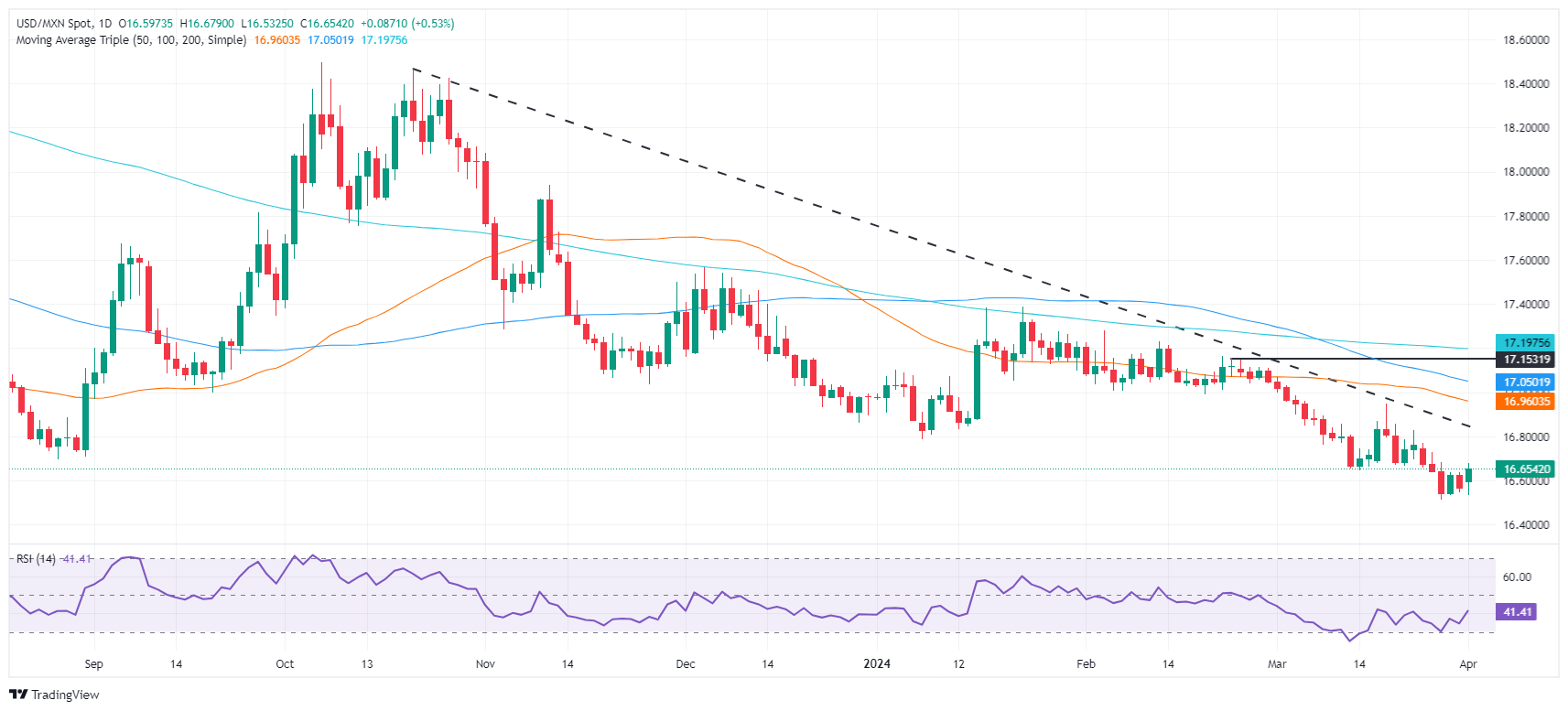Most recent article: Mexican Peso gains against US Dollar despite strong US data
- Mexican Peso drops as a reflection of investor reaction to upbeat US manufacturing figures and a surge in Treasury yields.
- Mexico's manufacturing sector shows stability, but stronger US economic outlook overshadows domestic positive data.
- Despite interest rate differential favoring Mexican Peso, hints emerge of possible Banxico rate cuts.
The Mexican Peso begins the week on a lower note versus the US Dollar, tumbling 0.57% after strong economic data from the United States (US) that could prevent the Federal Reserve (Fed) from cutting borrowing costs. That and a softer manufacturing activity report in Mexico kept the Greenback bid against the emerging market currency. The USD/MXN trades at 16.65, up 0.62%.
Mexico’s S&P Global Manufacturing PMI came at 52.2, virtually unchanged from 52.3 in February. Pollyanna de Lima, economic associate director at S&P Global, said, “Mexico's manufacturing sector expanded further in March, underpinned by a solid rise in domestic new orders as pending contracts continued to get the green light. This buoyant client appetite had positive impacts on factory production, buying levels and employment.”
Across the border, the Institute for Supply Management (ISM) revealed that manufacturing activity expanded for the first time in the US since September 2022, while an index of prices paid surprisingly jumped to levels last seen in August 2022.
The data sent US Treasury yields skyrocketing, while the US Dollar Index (DXY) soars above 105.00 and gains 0.49%. Upbeat data weighs on the Mexican currency, which has been appreciating by the wide interest rate differential between Mexico and the US.
Daily digest market movers: Mexican Peso treads water after strong US manufacturing activity figures
- Last Monday, Banxico Governor Victoria Rodriguez Ceja remained dovish despite acknowledging that the battle against inflation hasn’t been won. She added, “When macroeconomic conditions and the inflationary outlook allow us to make additional adjustments to the reference rate to the one we already have, I consider that they would be gradual.”
- A weaker Mexican Manufacturing PMI, along with the Indicator of General Economic Activity contracting in January, could open the door for further easing by Banxico. The latest meeting minutes will be released on April 4.
- The ISM Manufacturing PMI expanded by 50.3, above forecasts of 48.4, smashing February’s 47.8 reading. The Prices Paid Index expanded to 55.8, its highest level since August 2022, when it hit 52.5.
- S&P Global revealed the latest revision of March’s Manufacturing PMI for the United States, which came in at 51.9, up from the previous reading of 52.2.
- Last week, the Core Personal Consumption Expenditure (PCE) price index, the Fed’s favored gauge for inflation, cooled as expected.
- Chair Powell said at San Francisco Fed: “The fact that the US economy is growing at such a solid pace, the fact that the labor market is still very, very strong, gives us the chance to just be a little more confident about inflation coming down before we take the important step of cutting rates.”
Technical analysis: Mexican Peso at risk of shifting neutral as USD/MXN hovers around 16.65
The USD/MXN daily chart depicts that buyers lifted the exchange rate to a new four-day high of 16.67. Yet they still need to achieve a daily close above last year’s low of 16.62 before moving to test the 50-day Simple Moving Average (SMA) at 16.95. Further upside is seen at the 100-day SMA at 17.05, ahead of the 200-day SMA at 17.19.
On the flip side, the USD/MXN might extend its losses if it remains below 16.62. A breach of the current year-to-date (YTD) low of 16.51 can pave the way toward the October 2015 swing low of 16.32.
Mexican Peso FAQs
The Mexican Peso (MXN) is the most traded currency among its Latin American peers. Its value is broadly determined by the performance of the Mexican economy, the country’s central bank’s policy, the amount of foreign investment in the country and even the levels of remittances sent by Mexicans who live abroad, particularly in the United States. Geopolitical trends can also move MXN: for example, the process of nearshoring – or the decision by some firms to relocate manufacturing capacity and supply chains closer to their home countries – is also seen as a catalyst for the Mexican currency as the country is considered a key manufacturing hub in the American continent. Another catalyst for MXN is Oil prices as Mexico is a key exporter of the commodity.
The main objective of Mexico’s central bank, also known as Banxico, is to maintain inflation at low and stable levels (at or close to its target of 3%, the midpoint in a tolerance band of between 2% and 4%). To this end, the bank sets an appropriate level of interest rates. When inflation is too high, Banxico will attempt to tame it by raising interest rates, making it more expensive for households and businesses to borrow money, thus cooling demand and the overall economy. Higher interest rates are generally positive for the Mexican Peso (MXN) as they lead to higher yields, making the country a more attractive place for investors. On the contrary, lower interest rates tend to weaken MXN.
Macroeconomic data releases are key to assess the state of the economy and can have an impact on the Mexican Peso (MXN) valuation. A strong Mexican economy, based on high economic growth, low unemployment and high confidence is good for MXN. Not only does it attract more foreign investment but it may encourage the Bank of Mexico (Banxico) to increase interest rates, particularly if this strength comes together with elevated inflation. However, if economic data is weak, MXN is likely to depreciate.
As an emerging-market currency, the Mexican Peso (MXN) tends to strive during risk-on periods, or when investors perceive that broader market risks are low and thus are eager to engage with investments that carry a higher risk. Conversely, MXN tends to weaken at times of market turbulence or economic uncertainty as investors tend to sell higher-risk assets and flee to the more-stable safe havens.
Information on these pages contains forward-looking statements that involve risks and uncertainties. Markets and instruments profiled on this page are for informational purposes only and should not in any way come across as a recommendation to buy or sell in these assets. You should do your own thorough research before making any investment decisions. FXStreet does not in any way guarantee that this information is free from mistakes, errors, or material misstatements. It also does not guarantee that this information is of a timely nature. Investing in Open Markets involves a great deal of risk, including the loss of all or a portion of your investment, as well as emotional distress. All risks, losses and costs associated with investing, including total loss of principal, are your responsibility. The views and opinions expressed in this article are those of the authors and do not necessarily reflect the official policy or position of FXStreet nor its advertisers. The author will not be held responsible for information that is found at the end of links posted on this page.
If not otherwise explicitly mentioned in the body of the article, at the time of writing, the author has no position in any stock mentioned in this article and no business relationship with any company mentioned. The author has not received compensation for writing this article, other than from FXStreet.
FXStreet and the author do not provide personalized recommendations. The author makes no representations as to the accuracy, completeness, or suitability of this information. FXStreet and the author will not be liable for any errors, omissions or any losses, injuries or damages arising from this information and its display or use. Errors and omissions excepted.
The author and FXStreet are not registered investment advisors and nothing in this article is intended to be investment advice.
Recommended content
Editors’ Picks

AUD/USD clings to recovery gains above 0.6200, focus shifts to US ISM PMI
AUD/USD sustains the recovery from two-year troughs, holding above 0.6200 in Friday's Asian trading. The pair finds footing amid a pause in the US Dollar advance but the upside appears elusive as markets turn cautious amid China concerns and ahead of US ISM PMI data.

USD/JPY eases toward 157.00 as risk sentiment sours
USD/JPY is extending pullback from multi-month high of 158.07 set on Thursday. The pair drops toward 157.00 in the Asian session on Friday, courtesy of the negative shift in risk sentiment. Markets remain concerned about China's econmic health and the upcoming policies by the Fed and the BoJ.

Gold price appreciates amid Biden's discussions about potential strikes on Iran
Gold price edges higher for the fourth consecutive session on Friday, building on a stellar performance in 2024 with gains exceeding 27%, the metal’s best annual return since 2010. This sustained rally is attributed to strong safe-haven demand amid persistent geopolitical tensions in the Middle East and the prolonged Russia-Ukraine conflict.

Could XRP surge to new highs in January 2025? First two days of trading suggest an upside bias
Ripple's XRP is up 7% on Thursday, extending its rally that began during the New Year's Day celebration. If long-term holders continue their recent accumulation, XRP could overcome the $2.9 resistance level and aim for a new all-time high.

Three Fundamentals: Year-end flows, Jobless Claims and ISM Manufacturing PMI stand out Premium
Money managers may adjust their portfolios ahead of the year-end. Weekly US Jobless Claims serve as the first meaningful release in 2025. The ISM Manufacturing PMI provides an initial indication ahead of Nonfarm Payrolls.

Best Forex Brokers with Low Spreads
VERIFIED Low spreads are crucial for reducing trading costs. Explore top Forex brokers offering competitive spreads and high leverage. Compare options for EUR/USD, GBP/USD, USD/JPY, and Gold.
